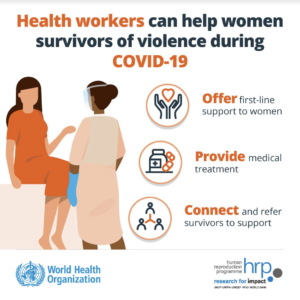Dr. Parveen A. Ali, Senior Lecturer, Division of Nursing and Midwifery, Health Sciences School, The University of Sheffield
Domestic Violence and Abuse encompasses a range of abuse and violence occurring within a domestic context in any form including child abuse, elder abuse and intimate partner violence. It is important to understand how COVID19 has affected domestic violence and abuse and what role healthcare professionals can play in this regard.
Domes tic violence and abuse in the United Kingdom (UK), is defined as any incident or pattern of incidents of controlling, coercive, threatening behaviour, violence or abuse between those aged 16 or over who are, or have been, intimate partners or family members regardless of gender or sexuality. The abuse can encompass, but is not limited to psychological, physical, sexual, financial or emotional. definition
tic violence and abuse in the United Kingdom (UK), is defined as any incident or pattern of incidents of controlling, coercive, threatening behaviour, violence or abuse between those aged 16 or over who are, or have been, intimate partners or family members regardless of gender or sexuality. The abuse can encompass, but is not limited to psychological, physical, sexual, financial or emotional. definition
The definition also covers acts of ‘honour’ based violence, female genital mutilation (FGM) [cutting] and forced marriage. The most common forms of domestic violence and abuse include physical, sexual and psychological abuse (WHO, 2002); however, it can also present as financial, social abuse and coercive control. Individuals may be exposed to one or more form of abuse at one time (Devries et al., 2013; World Health Organization, 2013). Globally, 30% of women experience physical or sexual violence by an intimate partner in their lifetime (World Health Organization, 2013).
The incidence and prevalence of violence against women tends to increase in any stressful event or emergency whether it is natural disaster, or a man made one. The COVID 19 pandemic has certainly caused a lot of stress, economic difficulties, disruption in social networks and to normal life. It also isolated people and affected their ability to move freely and access support which in turn exacerbated the risk for those experiencing violence. Available evidence and media reports suggest an incre ase in rate of domestic violence and abuse cases. Early data, provided by UN women, from the UK, the United States, France, Australia, Cyprus, Singapore, Argentina, Canada, Germany, and Spain indicates an increase in domestic violence and abuse and increased demands to women’s refuges, and other support services (UN Women, 2020).
ase in rate of domestic violence and abuse cases. Early data, provided by UN women, from the UK, the United States, France, Australia, Cyprus, Singapore, Argentina, Canada, Germany, and Spain indicates an increase in domestic violence and abuse and increased demands to women’s refuges, and other support services (UN Women, 2020).
In Hubei province of China, a police department reported stark increases in the domestic violence cases in February 2020. 90% of these cases were related to the covid-19 epidemic. The UK’s largest domestic abuse charity Refuge reported 700% calls in a single day under lockdown. The charity also reported a 300%+ increase in visits to its National Domestic Abuse Helpline website and a 950% rise in visits to their website compared to pre Covid-19. Another report suggests that the deaths from domestic abuse between 23 March and 12 April more than doubled (to 16 deaths) compared with the average rate in the previous 10 years.
The situation can be worse for women with additional vulnerabilities such as those with disabilities, older women, girls and women living in institutional setting, displaced women and women living in conflict affected areas as they face further barriers in accessing appropriate support services. Examples could be lack of knowledge, lack of services, lack of social networks, language barriers to name a few.
| Physical violence | Use of physical force to inflict pain, injury or physical suffering to the victim |
Slapping, beating, kicking, pinching, biting, pushing, shoving, dragging, stabbing, spanking, scratching, hitting with a fist or something else that could hurt, burning, choking, threatening or using a gun, knife or any other weapon
|
| Sexual violence | any sexual act, attempt to obtain a sexual act, unwanted sexual comments or advances, or acts to traffic, or otherwise directed, against a person’s sexuality using coercion, by any person, regardless of their relationship to the victim, in any setting, including but not limited to home and work
|
Physically forcing a partner to have sexual intercourse, forcing a partner to do something that they found degrading or humiliating, harming them during sex, forcing partner to have sex without protection |
| Psychological violence | use of various behaviours intended to humiliate and control another individual in public or private |
verbal abuse, name calling, blackmailing, constantly criticizing, embarrassing the victim by saying something or doing something, threats to beat women or children, monitoring and restricting movements, restricting access to friends and family, restricting economic independence and access to information, assistance or other resources and services such as education or health services
|
| Financial or Economical Abuse | Controlling a person’s ability to acquire, use and maintain their own money and resources. |
not letting victims work; sabotaging job interviews, taking the welfare benefits the victim is entitled to, using their money without consent, building up debts in their name, damaging their property and possessions, withholding maintenance payments
|
| Coercive control |
any act or a pattern of acts of assault, threats, humiliation and intimidation or other abuse that is used to harm, punish, or frighten their victim |
|
| Online Abuse |
Stalking someone online
|
Health care systems and healthcare providers have a very important role to play in these situations and they can do this by ensuring appropriate training and education of the healthcare professionals including doctors, nurses, midwives, and other frontline practitioners. They need to be trained to be able to assess risk in remote and face to face consultations to ensure provision of appropriate and compassionate care. They also need to be able to refer people to appropriate services in the local and regional areas. There is a need to develop and implement appropriate referral pathways of available services including information about support services, helplines, children services, social services, psychological support and counselling services. At the same time, organisations that support people in conflict affected areas should be sensitive of the needs of women subjected to violence and its impact on their children in their COVID19 response plans.
In addition, we need to have reliable information collected about the issues so that we understand the scope of the issue to enable development of appropriate strategies to solve the issue.
COVID19 will not be the last pandemic or emergency as history suggest such emergency situation arise overtime. Learning from the situation in COVID19 should be used to prepare ourselves better to respond to the crises better but to also understand and impact of such emergencies on those experiencing domestic violence and abuse and how these impacts can be mitigated.
a list of the main organisations is available here.
Women’s Aid also has a list of useful links for websites and organisations providing relevant information and support.
Further Resources to learn about Domestic Violence and Abuse
Supporting Victims of Domestic Violence
Recognising and Responding to Domestic Abuse: Training Game
For more Photos, Project, Talk and Podcast Check this out:
Phoenix: Impact of Domestic Violence and Abuse
